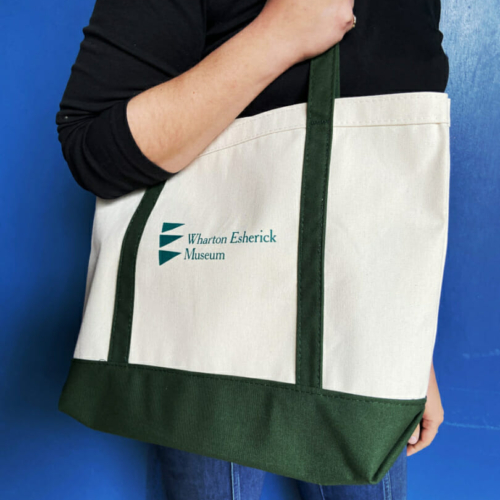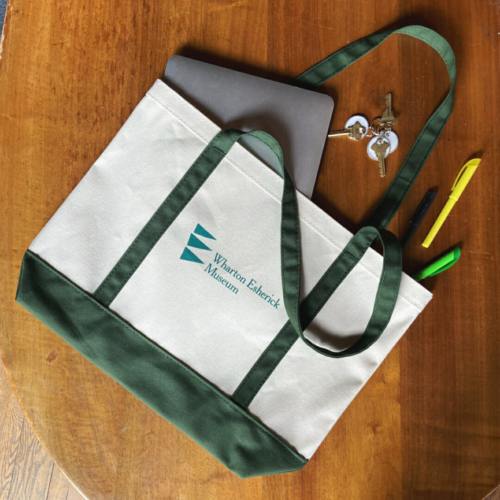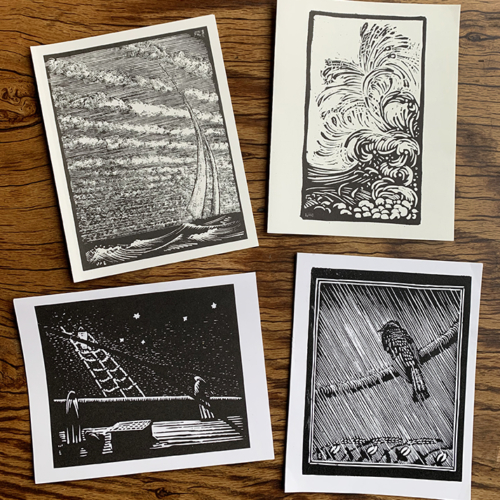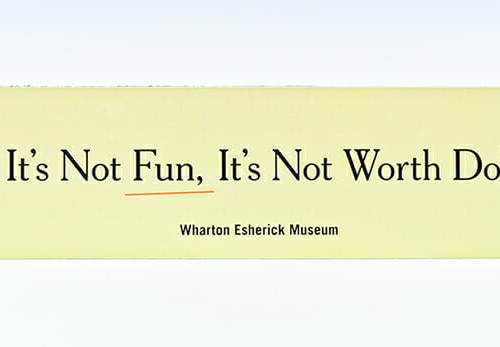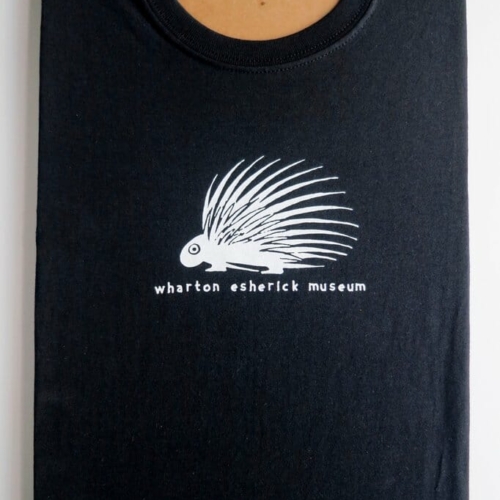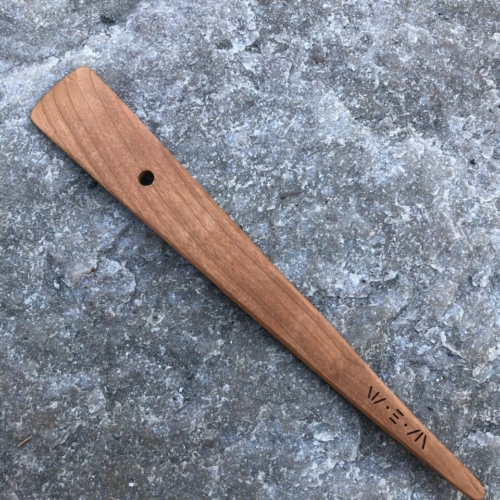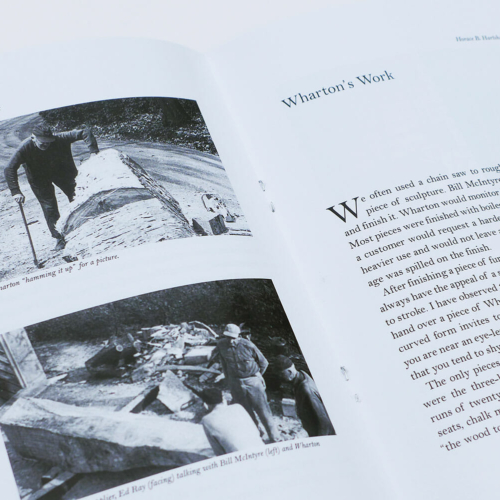-
 Looking for the perfect addition to your workshop overalls? How about our Porcupine Enamel Pin! A playful interpretation of Esherick's woodcut illustration for a collection of essays published by Centaur press in 1926. It measures 1" x 1.5" and provides a perfect little reminder to stay inspired no matter what you're working on.
Looking for the perfect addition to your workshop overalls? How about our Porcupine Enamel Pin! A playful interpretation of Esherick's woodcut illustration for a collection of essays published by Centaur press in 1926. It measures 1" x 1.5" and provides a perfect little reminder to stay inspired no matter what you're working on. -

 We’re celebrating Esherick’s printmaking with an exciting new shop item – Holzhausen Tea Towels! These tea towels bring a little piece of the Studio into your home, capturing the spirit of Esherick’s gift to his friend Hanna Weil, for whom he made a set of curtains with this dynamic repeating pattern. ‘Holzhausen’ is both the town in Germany where Hanna lived and Esherick’s title for his woodblock print depicting the view from her front porch. Screenprinted by Philadelphia-based artist and printmaker Marcus Benavides. Measures 28" x 28"
We’re celebrating Esherick’s printmaking with an exciting new shop item – Holzhausen Tea Towels! These tea towels bring a little piece of the Studio into your home, capturing the spirit of Esherick’s gift to his friend Hanna Weil, for whom he made a set of curtains with this dynamic repeating pattern. ‘Holzhausen’ is both the town in Germany where Hanna lived and Esherick’s title for his woodblock print depicting the view from her front porch. Screenprinted by Philadelphia-based artist and printmaker Marcus Benavides. Measures 28" x 28" -
 Looking for the perfect addition to your workshop overalls? How about our "Winnie" Enamel Pin! This playful interpretation of Esherick's 1930 "Winnie the Pooh" sculpture -- who greets visitors to the Museum at our Visitor Center and on the Studio deck -- measures 1" x 1.5" and provides a perfect little reminder to stay inspired no matter what you're working on.
Looking for the perfect addition to your workshop overalls? How about our "Winnie" Enamel Pin! This playful interpretation of Esherick's 1930 "Winnie the Pooh" sculpture -- who greets visitors to the Museum at our Visitor Center and on the Studio deck -- measures 1" x 1.5" and provides a perfect little reminder to stay inspired no matter what you're working on. -
Out of stock

 Turquoise Awning, Porcelain, underglaze, glaze. 14" H x 6" W x 4" D Created by WEM Artist-in-Residence Roberta Massuch, this one-of-a-kind ceramic vessel was inspired by elements of Esherick's Studio. https://www.robertamassuch.com/ Learn more about the Roberta Massuch: Artist-in-Residence exhibition, which features new site-specific works that reflect Roberta's sensitive and slow observation of Esherick’s idiosyncratic home and studio over the course of many months. ITEM# RAM-WEM3
Turquoise Awning, Porcelain, underglaze, glaze. 14" H x 6" W x 4" D Created by WEM Artist-in-Residence Roberta Massuch, this one-of-a-kind ceramic vessel was inspired by elements of Esherick's Studio. https://www.robertamassuch.com/ Learn more about the Roberta Massuch: Artist-in-Residence exhibition, which features new site-specific works that reflect Roberta's sensitive and slow observation of Esherick’s idiosyncratic home and studio over the course of many months. ITEM# RAM-WEM3 -
Out of stock

 Yellow Grid Vessel, Porcelain, underglaze, glaze. 13" H x 7" W x 4" D Created by WEM Artist-in-Residence Roberta Massuch, this one-of-a-kind ceramic vessel was inspired by elements of Esherick's Studio. https://www.robertamassuch.com/ Learn more about the Roberta Massuch: Artist-in-Residence exhibition, which features new site-specific works that reflect Roberta's sensitive and slow observation of Esherick’s idiosyncratic home and studio over the course of many months. ITEM# RAM-WEM2
Yellow Grid Vessel, Porcelain, underglaze, glaze. 13" H x 7" W x 4" D Created by WEM Artist-in-Residence Roberta Massuch, this one-of-a-kind ceramic vessel was inspired by elements of Esherick's Studio. https://www.robertamassuch.com/ Learn more about the Roberta Massuch: Artist-in-Residence exhibition, which features new site-specific works that reflect Roberta's sensitive and slow observation of Esherick’s idiosyncratic home and studio over the course of many months. ITEM# RAM-WEM2 -
Out of stock

 Primary Vessel, Porcelain, underglaze, glaze. 11" H x 9" W x 9" D Created by WEM Artist-in-Residence Roberta Massuch, this one-of-a-kind ceramic vessel was inspired by elements of Esherick's Studio. https://www.robertamassuch.com/ Learn more about the Roberta Massuch: Artist-in-Residence exhibition, which features new site-specific works that reflect Roberta's sensitive and slow observation of Esherick’s idiosyncratic home and studio over the course of many months. ITEM# RAM-WEM1
Primary Vessel, Porcelain, underglaze, glaze. 11" H x 9" W x 9" D Created by WEM Artist-in-Residence Roberta Massuch, this one-of-a-kind ceramic vessel was inspired by elements of Esherick's Studio. https://www.robertamassuch.com/ Learn more about the Roberta Massuch: Artist-in-Residence exhibition, which features new site-specific works that reflect Roberta's sensitive and slow observation of Esherick’s idiosyncratic home and studio over the course of many months. ITEM# RAM-WEM1 -


Established in 1999, Historic Artists’ Homes and Studios (HAHS), a program of the National Trust for Historic Preservation, is a coalition of museums throughout the country that were the homes and studios of American artists. From the desert vistas of Georgia O’Keeffe’s New Mexico ranch to Winslow Homer’s studio on the rocky, windswept coast of southern Maine, the homes and studios in the network are sites of extraordinary creativity. The Wharton Esherick Museum is proud to be a founding HAHS member, and a site featured in this publication.
Guide to Historic Artists’ Homes & Studios is the first guidebook to the network, conveying each artist’s visual legacy and setting each site in the context of its architecture and landscape, which often were designed by the artists themselves. Through portraits, artwork, and site photos, discover the powerful influence of place on American greats such as Andrew Wyeth, Grant Wood, Lee Krasner, and Donald Judd, as well as lesser-known but equally creative figures who made important contributions to cultural history---multimedia artist James Castle, photographer Alice Austen, and muralist Clementine Hunter among them.
Organized by region Guide to Historic Artists’ Homes & Studios weaves the history of the sites’ architecture and landscape with the artists’ biographies and their visual legacy. The guide features portraits of the artists, examples of their artwork, site descriptions, and photographs as well as visitor information and a site map.
Guide to Historic Artists’ Homes & Studios: A Program of the National Trust for Historic PreservationBy Valerie A. Balint | Foreword by Wanda M. Corn, Preface by Donna Hassler and Katherine Malone-France
Publication date: June 2, 2020. Paperback with flaps. 256 pages. 225 Color & B+W photographs.Cover photo by Don Freeman, 2019
-

 Packs of winter-themed Esherick woodcut print notecards. Each pack includes 'The Lane,' 'December,' and 'Christmas Snow.' 12 cards in a pack. More about the woodcuts: 'The Lane' features the snowy drive of Esherick's friend and patron Helene Fischer's home in the West Mount Airy neighborhood of Philadelphia. 'December' depicts the Esherick's own home, "Sunekrest," the 19th-century farmhouse he and his wife Letty first lived when they moved to the Paoli countryside. 'Christmas Snow' is a lovely snowy depiction of the home of Dorothy Cantrell.
Packs of winter-themed Esherick woodcut print notecards. Each pack includes 'The Lane,' 'December,' and 'Christmas Snow.' 12 cards in a pack. More about the woodcuts: 'The Lane' features the snowy drive of Esherick's friend and patron Helene Fischer's home in the West Mount Airy neighborhood of Philadelphia. 'December' depicts the Esherick's own home, "Sunekrest," the 19th-century farmhouse he and his wife Letty first lived when they moved to the Paoli countryside. 'Christmas Snow' is a lovely snowy depiction of the home of Dorothy Cantrell. -
 2018 edition of the Horse-Shoe Trail Guidebook with 10 full-color topographical maps. The Horse-Shoe Trail is a public trail for hiking and horseback riding. It begins in Valley Forge and continues westward for over 140 miles to its junction with the Appalachian Trail on the crest of Stony Mountain north of Hershey. This trail guide, along with a complete set of maps, is a valuable resource for planning your hike on this historic trail. The guide is 73 pages long and contains 10 fold out topographical maps showing the route of the trail.
2018 edition of the Horse-Shoe Trail Guidebook with 10 full-color topographical maps. The Horse-Shoe Trail is a public trail for hiking and horseback riding. It begins in Valley Forge and continues westward for over 140 miles to its junction with the Appalachian Trail on the crest of Stony Mountain north of Hershey. This trail guide, along with a complete set of maps, is a valuable resource for planning your hike on this historic trail. The guide is 73 pages long and contains 10 fold out topographical maps showing the route of the trail. -
 Purchase tickets for an Experiencing Esherick tour to give as gifts to friends and family! Everyone knows someone they'd like to visit the Wharton Esherick Museum! Guest tickets are valued at $20 each (one adult admission to an Experiencing Esherick Tour) and come mailed with a brochure. » Prefer paperless? You can send gift tickets to your loved one via email! Purchase digital gift tickets here.
Purchase tickets for an Experiencing Esherick tour to give as gifts to friends and family! Everyone knows someone they'd like to visit the Wharton Esherick Museum! Guest tickets are valued at $20 each (one adult admission to an Experiencing Esherick Tour) and come mailed with a brochure. » Prefer paperless? You can send gift tickets to your loved one via email! Purchase digital gift tickets here. -

 Artist Wharton Esherick (1887-1970) is best known for his sculptural wood pieces and the way he applied the principles of sculpture to designs for functional objects. His pioneering work has made him an inspiration to fine woodworkers worldwide, helping to elevate the medium from craft to major art museums. Much of Esherick’s work is now on display in this rural studio he built on a hillside in Pennsylvania. This catalog documents, with beautiful color photography, more than 130 paintings, woodblock prints, sculpture, and utilitarian objects found at the Wharton Esherick Museum. One gains an appreciation for the range and depth of Esherick’s work when these pieces can be studied individually.
Artist Wharton Esherick (1887-1970) is best known for his sculptural wood pieces and the way he applied the principles of sculpture to designs for functional objects. His pioneering work has made him an inspiration to fine woodworkers worldwide, helping to elevate the medium from craft to major art museums. Much of Esherick’s work is now on display in this rural studio he built on a hillside in Pennsylvania. This catalog documents, with beautiful color photography, more than 130 paintings, woodblock prints, sculpture, and utilitarian objects found at the Wharton Esherick Museum. One gains an appreciation for the range and depth of Esherick’s work when these pieces can be studied individually. -
 Wharton Esherick and the Birth of the American Modern explores Esherick’s artistic evolution during the early decades of the twentieth century, culminating in the exhibition of his work as part of the Pennsylvania Hill House at the 1940 World's Fair in New York City. Trained as an illustrator and painter, experienced in modern theater and dance, well exposed to new ideas in philosophy, politics, and literature, Esherick experimented with woodcarving and printmaking, laying the foundation for his emergence as an artist of remarkable range.
Wharton Esherick and the Birth of the American Modern explores Esherick’s artistic evolution during the early decades of the twentieth century, culminating in the exhibition of his work as part of the Pennsylvania Hill House at the 1940 World's Fair in New York City. Trained as an illustrator and painter, experienced in modern theater and dance, well exposed to new ideas in philosophy, politics, and literature, Esherick experimented with woodcarving and printmaking, laying the foundation for his emergence as an artist of remarkable range. -

 In 1922, Wharton Esherick showed a copy Rhymes of Early Jungle Folk, which he had illustrated with woodcut prints, to Harold Mason, owner of the Centaur Bookshop in Philadelphia. Impressed by what he saw, Mason asked Esherick to illustrate Walt Whitman’s Song of the Broad-Axe, which Mason published in a limited edition in 1924. Inspired by the woodcuts, Esherick created a hand-bound prototype book of Whitman’s poem, using prints made directly from his blocks and hand-lettering it in Esherick’s own calligraphic style. Illuminated letters were used to begin paragraphs, and spaces at the end of lines were filled with blue and yellow drawings that reflect the content of the verses. The result of this labor of love was a work of art, 17x12 inches, with pages of handmade paper, folded and uncut. This book is a reproduction of Esherick’s prototype, authorized by the Wharton Esherick Museum. Though this edition is smaller than the prototype book, the original was carefully scanned and printed to provide as true a reproduction as possible. It faithfully captures the artist’s vision and skill and, for the first time, makes this wonderful work available to the general public. It will be appreciated by all admirers of Esherick, Whitman, and lovers of fine books.
In 1922, Wharton Esherick showed a copy Rhymes of Early Jungle Folk, which he had illustrated with woodcut prints, to Harold Mason, owner of the Centaur Bookshop in Philadelphia. Impressed by what he saw, Mason asked Esherick to illustrate Walt Whitman’s Song of the Broad-Axe, which Mason published in a limited edition in 1924. Inspired by the woodcuts, Esherick created a hand-bound prototype book of Whitman’s poem, using prints made directly from his blocks and hand-lettering it in Esherick’s own calligraphic style. Illuminated letters were used to begin paragraphs, and spaces at the end of lines were filled with blue and yellow drawings that reflect the content of the verses. The result of this labor of love was a work of art, 17x12 inches, with pages of handmade paper, folded and uncut. This book is a reproduction of Esherick’s prototype, authorized by the Wharton Esherick Museum. Though this edition is smaller than the prototype book, the original was carefully scanned and printed to provide as true a reproduction as possible. It faithfully captures the artist’s vision and skill and, for the first time, makes this wonderful work available to the general public. It will be appreciated by all admirers of Esherick, Whitman, and lovers of fine books. -
 The Society was very pleased to have the opportunity to collaborate with Bob Bascom and the Wharton Esherick Society staff in the production of this special publication and celebrates the life of a truly remarkable woman, and shares some of the stories from her lifelong relationship with her beloved husband, their family, and the community.
The Society was very pleased to have the opportunity to collaborate with Bob Bascom and the Wharton Esherick Society staff in the production of this special publication and celebrates the life of a truly remarkable woman, and shares some of the stories from her lifelong relationship with her beloved husband, their family, and the community. -
 This facsimile edition of a 1922 children’s book features seventy-three dynamic and whimsical woodcut illustrations—the first woodcuts that the famed American craftsman Wharton Esherick produced. A high-quality replica authorized by the Wharton Esherick Museum, this book reveals the foundation of Esherick’s direction as an artist. Edited by Museum director Paul Eisenhauer, it also features a foreword by Museum assistant curator Laura Heemer. The illustrations frame verses that introduce children to the principles of evolution, a highly controversial topic at the time: the book was published three years before the famous Scopes “Monkey” trial of 1925 that resulted in the inclusion of the teaching of evolution in public schools. Drawn by the excitement of the controversy, Esherick threw his passion into these illustrations. Afterward he would go on to carve over 300 woodcuts, leading to decorative carving, and ultimately, to Esherick’s realization that he was a sculptor rather than a painter.
This facsimile edition of a 1922 children’s book features seventy-three dynamic and whimsical woodcut illustrations—the first woodcuts that the famed American craftsman Wharton Esherick produced. A high-quality replica authorized by the Wharton Esherick Museum, this book reveals the foundation of Esherick’s direction as an artist. Edited by Museum director Paul Eisenhauer, it also features a foreword by Museum assistant curator Laura Heemer. The illustrations frame verses that introduce children to the principles of evolution, a highly controversial topic at the time: the book was published three years before the famous Scopes “Monkey” trial of 1925 that resulted in the inclusion of the teaching of evolution in public schools. Drawn by the excitement of the controversy, Esherick threw his passion into these illustrations. Afterward he would go on to carve over 300 woodcuts, leading to decorative carving, and ultimately, to Esherick’s realization that he was a sculptor rather than a painter. -

 An intimate and revealing collection of photographs of astonishingly beautiful, iconic, and undiscovered mid-century interiors. Among significant mid-century interiors, none are more celebrated yet underpublished as the homes created by architects and interior designers for themselves. This collection of newly commissioned photographs presents the most compelling homes by influential mid-century designers, such as Russel Wright, George Nakashima, Harry Bertoia, Charles and Ray Eames, and Eva Zeisel, among others. Intimate as well as revelatory, Williamson’s photographs show these creative homes as they were lived in by their designers: Walter Gropius’s historic Bauhaus home in Massachusetts; Albert Frey’s floating modernist aerie on a Palm Springs rock outcropping; Wharton Esherick’s completely handmade Pennsylvania house, from the organic handcarved staircase to the iconic furniture. Personal and breathtaking by turn—these homes are exemplary studies of domestic modernism at its warmest and most creative.
An intimate and revealing collection of photographs of astonishingly beautiful, iconic, and undiscovered mid-century interiors. Among significant mid-century interiors, none are more celebrated yet underpublished as the homes created by architects and interior designers for themselves. This collection of newly commissioned photographs presents the most compelling homes by influential mid-century designers, such as Russel Wright, George Nakashima, Harry Bertoia, Charles and Ray Eames, and Eva Zeisel, among others. Intimate as well as revelatory, Williamson’s photographs show these creative homes as they were lived in by their designers: Walter Gropius’s historic Bauhaus home in Massachusetts; Albert Frey’s floating modernist aerie on a Palm Springs rock outcropping; Wharton Esherick’s completely handmade Pennsylvania house, from the organic handcarved staircase to the iconic furniture. Personal and breathtaking by turn—these homes are exemplary studies of domestic modernism at its warmest and most creative. -
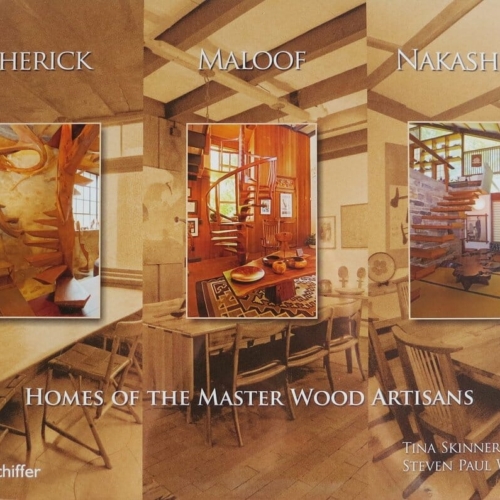 A rich collection of imagery explores the actual homes of three of the most esteemed wood artist/craftsmen of the modern era: Wharton Esherick, Sam Maloofi, and George Nakashima. Tour the private homes of these masters and compare their innovation and vision through the medium of their own homes, gardens, and work areas. Step into their environments, where aesthetics are most accurately realized. You’ll delight in Esherick’s humble mountaintop home where straight lines were purposefully forbidden, and Maloof’s sprawling California home that expresses his inexhaustible creativity and industriousness. Nakashima‘s home is a harmonious marriage of Japanese influences with Pennsylvania’s rich natural resources. This book is a must-have for devotees of these artists, as well as aspiring woodworkers who want tutelage from the top.
A rich collection of imagery explores the actual homes of three of the most esteemed wood artist/craftsmen of the modern era: Wharton Esherick, Sam Maloofi, and George Nakashima. Tour the private homes of these masters and compare their innovation and vision through the medium of their own homes, gardens, and work areas. Step into their environments, where aesthetics are most accurately realized. You’ll delight in Esherick’s humble mountaintop home where straight lines were purposefully forbidden, and Maloof’s sprawling California home that expresses his inexhaustible creativity and industriousness. Nakashima‘s home is a harmonious marriage of Japanese influences with Pennsylvania’s rich natural resources. This book is a must-have for devotees of these artists, as well as aspiring woodworkers who want tutelage from the top.

